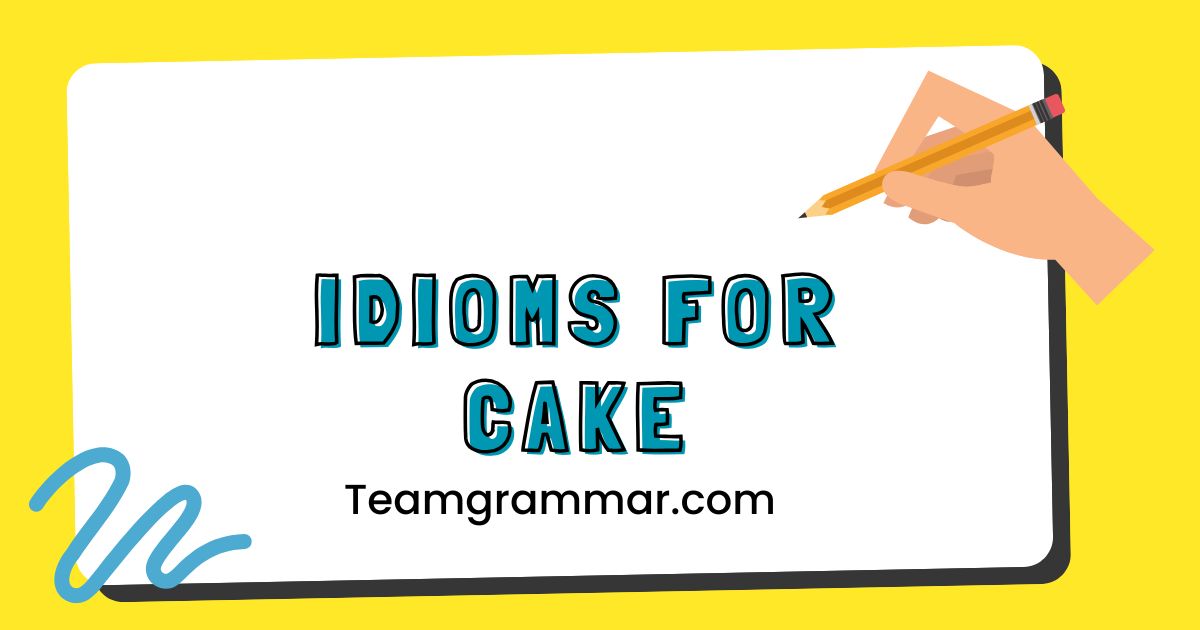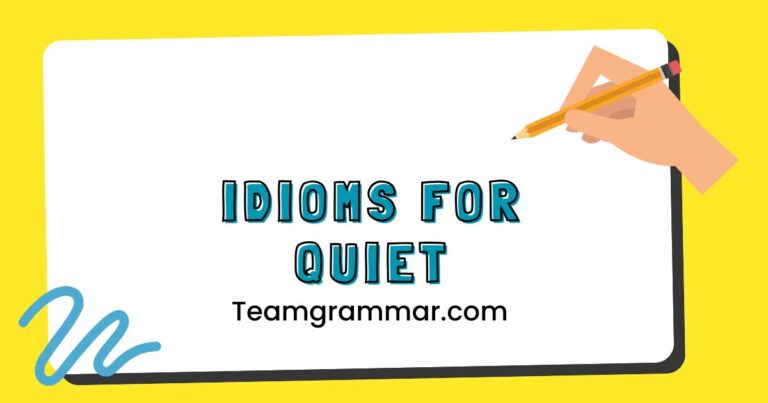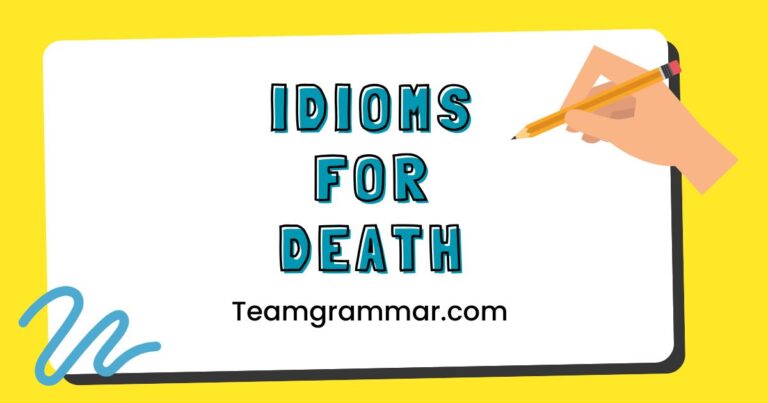49 Idioms for Cake: A Sweet Guide to English Expressions
Idioms add color and nuance to the English language, allowing speakers to convey complex meanings with concise and often humorous expressions. Understanding idioms, particularly those related to familiar concepts like cake, is crucial for mastering English fluency and comprehension.
This article provides a comprehensive guide to cake-related idioms, exploring their meanings, origins, and usage. This resource is designed for English language learners of all levels who wish to enrich their vocabulary and gain a deeper understanding of idiomatic English.
Table of Contents
- Introduction
- Definition of Idioms
- Structural Breakdown of Idioms
- Types and Categories of Cake Idioms
- Examples of Cake Idioms
- Usage Rules for Cake Idioms
- Common Mistakes with Cake Idioms
- Practice Exercises
- Advanced Topics
- FAQ
- Conclusion
Definition of Idioms
An idiom is a phrase or expression whose meaning cannot be understood from the literal meanings of the individual words. Instead, idioms have a figurative meaning that is culturally specific.
They are a type of figurative language that adds depth and color to communication. Idioms are essential for understanding the nuances of a language and communicating effectively with native speakers.
Classification:Idioms are classified as a type of figurative language, alongside metaphors, similes, and personification. They differ from these other figures of speech in that their meaning is not directly implied by the words themselves but rather is established through common usage and cultural understanding.
For example, the idiom “break a leg” literally means to injure oneself, but figuratively it means “good luck.”
Function:The primary function of idioms is to add expressiveness and color to language. They allow speakers to convey complex ideas and emotions in a concise and memorable way.
Idioms can also serve as a form of social bonding, as using them correctly signals familiarity with the cultural norms of a language community.
Contexts:Idioms are used in a wide variety of contexts, from informal conversations to formal writing. However, it is important to be aware of the specific context and audience when using idioms, as some may be considered inappropriate or offensive in certain situations.
For example, some idioms may be too informal for a business presentation, while others may be offensive to people from different cultural backgrounds.
Structural Breakdown of Idioms
The structure of an idiom can vary greatly depending on its origin and usage. Some idioms are simple phrases, while others are more complex sentences.
However, all idioms share the common characteristic of having a non-literal meaning that is different from the sum of the meanings of their individual words.
Many idioms follow common grammatical patterns, such as subject-verb-object or prepositional phrases. However, the key to understanding idioms is to recognize that their meaning is not determined by their grammatical structure but rather by their established usage in the language.
For example, the idiom “kick the bucket” follows a typical subject-verb-object structure, but its meaning (“to die”) has nothing to do with kicking or buckets.
Here’s a breakdown of common structural elements in idioms:
- Phrasal verbs: Many idioms are based on phrasal verbs, which are verbs combined with prepositions or adverbs to create a new meaning. Example: “look up to” (to admire).
- Metaphorical language: Idioms often use metaphors to create a figurative meaning. Example: “raining cats and dogs” (raining heavily).
- Fixed expressions: Some idioms are fixed expressions, meaning that their words and order cannot be changed without altering their meaning. Example: “spill the beans” (reveal a secret).
Understanding these structural elements can help learners identify and interpret idioms more effectively. However, the best way to learn idioms is through exposure and practice, as their meanings are often arbitrary and culturally specific.
Types and Categories of Cake Idioms
Cake idioms, like all idioms, can be categorized based on their meaning and usage. Here are some common categories of cake-related idioms:
1. Ease or Simplicity
These idioms often describe something that is easy to accomplish or understand. They typically use the image of cake to convey the idea of something being simple and enjoyable.
2. Desirability or Advantage
These idioms highlight the desirable or advantageous nature of something. They often use the image of cake to represent something that is pleasurable or beneficial.
3. Having It All
These idioms express the idea of wanting to enjoy all the benefits of a situation without any of the drawbacks. They often use the image of cake to represent the desire for complete satisfaction.
4. Extra Benefit or Bonus
These idioms describe something that is an additional benefit or bonus on top of something already good. They often use the image of cake to represent the underlying good thing, and the icing to represent the extra benefit.
Examples of Cake Idioms
Cake idioms are frequently used in everyday conversation and writing. Understanding these idioms can significantly improve your comprehension and fluency in English.
Let’s explore some of the most common cake idioms with detailed explanations and examples.
“A Piece of Cake”
Meaning: This idiom means that something is very easy to do. It implies that the task is as simple and enjoyable as eating a piece of cake.
Origin: The exact origin is debated, but it likely emerged in the early 20th century, drawing on the association of cake with pleasure and ease.
Usage: This idiom is commonly used in informal settings to describe tasks that are not challenging.
The following table provides examples of how to use “a piece of cake” in sentences:
| Example | Explanation |
|---|---|
| “The exam was a piece of cake; I finished it in half the time.” | The exam was very easy. |
| “Learning to ride a bike was a piece of cake for her.” | She learned to ride a bike very easily. |
| “Don’t worry, fixing the computer is a piece of cake for me.” | He finds fixing computers very easy. |
| “Getting a driver’s license was a piece of cake after all the practice.” | Obtaining the driver’s license was easy due to practice. |
| “For him, solving that math problem was a piece of cake.” | He found the math problem very easy to solve. |
| “Baking that cake was a piece of cake, even for a beginner.” | The cake was easy to bake, even for someone new to baking. |
| “Negotiating the deal was a piece of cake with her experience.” | Her experience made negotiating the deal easy. |
| “Climbing that hill was a piece of cake compared to the mountain.” | The hill was easy to climb compared to the mountain. |
| “Installing the software was a piece of cake thanks to the clear instructions.” | The clear instructions made installing the software easy. |
| “Teaching him to swim was a piece of cake; he picked it up quickly.” | He learned to swim very easily. |
| “Getting tickets to the concert was a piece of cake online.” | It was very easy to get tickets online. |
| “Finding the house was a piece of cake with GPS.” | Using GPS made finding the house easy. |
| “The presentation was a piece of cake after all the rehearsals.” | The rehearsals made the presentation very easy. |
| “Downloading the app was a piece of cake on my new phone.” | Downloading the app was very easy on the new phone. |
| “Remembering all the names was a piece of cake because they were all so friendly.” | The friendliness of the people made remembering names easy. |
| “Getting a table at the restaurant was a piece of cake because we arrived early.” | Arriving early made getting a table easy. |
| “Packing for the trip was a piece of cake with a detailed list.” | The detailed list made packing easy. |
| “Winning the game was a piece of cake because our team was well-prepared.” | The team’s preparation made winning easy. |
| “Learning the new software was a piece of cake with the tutorials.” | The tutorials made learning the software easy. |
| “Adapting to the new school was a piece of cake for her.” | Adapting to the new school was easy for her. |
| “For the experienced chef, preparing the gourmet meal was a piece of cake.” | The chef found preparing the meal very easy due to his experience. |
“Have Your Cake and Eat It Too”
Meaning: This idiom means that you can’t enjoy the advantages of something without also accepting the disadvantages. It implies that you can’t have everything you want.
Origin: This idiom has been around for centuries, with early versions appearing in the 16th century. It highlights the impossibility of consuming something and still possessing it.
Usage: This idiom is used to point out when someone is trying to avoid the consequences of their actions or choices.
The following table provides examples of how to use “have your cake and eat it too” in sentences:
| Example | Explanation |
|---|---|
| “You can’t have your cake and eat it too; you have to choose between the two jobs.” | You can’t enjoy the benefits of both jobs; you must pick one. |
| “She wants to travel the world and save money, but you can’t have your cake and eat it too.” | She can’t do both things simultaneously. |
| “He wants to be a successful businessman and spend all his time relaxing, but he can’t have his cake and eat it too.” | He can’t achieve both goals at the same time. |
| “They want to reduce taxes and increase government spending, but you can’t have your cake and eat it too.” | They can’t do both things simultaneously. |
| “You can’t have your cake and eat it too; you need to decide whether you want to be single or in a relationship.” | You can’t enjoy the benefits of both being single and being in a relationship. |
| “He wants to eat all the cookies and still lose weight, but he can’t have his cake and eat it too.” | He can’t enjoy both eating cookies and losing weight. |
| “She wants to keep her old car but also have the latest features; she can’t have her cake and eat it too.” | She can’t enjoy the benefits of both her old car and the latest features. |
| “You can’t have your cake and eat it too; you must choose between investing and spending the money.” | You can’t do both things simultaneously. |
| “He wants to live in the city and have a big backyard, but he can’t have his cake and eat it too.” | He can’t enjoy the benefits of both living in the city and having a big backyard. |
| “She wants to be famous but also have complete privacy; she can’t have her cake and eat it too.” | She can’t enjoy the benefits of both being famous and having complete privacy. |
| “You can’t have your cake and eat it too; you need to decide if you want to prioritize your career or your family.” | You can’t fully dedicate yourself to both your career and your family at the same time. |
| “He wants to have a high salary and a job with no responsibility, but he can’t have his cake and eat it too.” | He can’t enjoy the benefits of both a high salary and a job with no responsibility. |
| “She wants to go to college and start working full-time immediately, but she can’t have her cake and eat it too.” | She can’t fully dedicate herself to both college and full-time work. |
| “You can’t have your cake and eat it too; you must choose between speed and accuracy.” | You can’t maximize both speed and accuracy at the same time. |
| “He wants to have a new house and save all of his money, but he can’t have his cake and eat it too.” | He can’t enjoy the benefits of both having a new house and saving all of his money. |
| “She wants to always be right and never admit when she’s wrong, but she can’t have her cake and eat it too.” | She can’t enjoy the benefits of both always being right and never admitting when she’s wrong. |
| “You can’t have your cake and eat it too; you have to decide whether you want to spend time with your friends or study for the exam.” | You can’t fully dedicate yourself to both spending time with friends and studying for the exam. |
| “He wants to eat healthy and eat junk food all the time, but he can’t have his cake and eat it too.” | He can’t enjoy the benefits of both eating healthy and eating junk food all the time. |
| “She wants to keep her old clothes and buy all new outfits, but she can’t have her cake and eat it too.” | She can’t enjoy the benefits of both keeping her old clothes and buying all new outfits. |
| “You can’t have your cake and eat it too; you must choose between living in the present and worrying about the future.” | You can’t fully dedicate yourself to both living in the present and worrying about the future. |
| “He wants to be a successful artist and avoid any criticism, but he can’t have his cake and eat it too.” | He can’t enjoy the benefits of both being a successful artist and avoiding any criticism. |
“Icing on the Cake”
Meaning: This idiom refers to something that is an additional benefit or bonus to something that is already good. It implies that the original thing is already desirable, and the additional element makes it even better.
Origin: The origin is straightforward, drawing on the fact that icing enhances an already enjoyable cake.
Usage: This idiom is used to describe something that is a pleasant addition to an already positive situation.
The following table provides examples of how to use “icing on the cake” in sentences:
| Example | Explanation |
|---|---|
| “Getting the job was great, but the high salary was the icing on the cake.” | The high salary was an additional benefit to getting the job. |
| “The vacation was amazing, and the free upgrade to a suite was the icing on the cake.” | The free upgrade made the vacation even better. |
| “Winning the game was fantastic, and setting a new record was the icing on the cake.” | Setting a new record made winning the game even better. |
| “The concert was incredible, and meeting the band backstage was the icing on the cake.” | Meeting the band made the concert even better. |
| “The car was perfect, and the included warranty was the icing on the cake.” | The included warranty made the car even more desirable. |
| “The party was fun, and the surprise guest was the icing on the cake.” | The surprise guest made the party even better. |
| “The house was beautiful, and the large garden was the icing on the cake.” | The large garden made the house even more desirable. |
| “The gift was thoughtful, and the handwritten card was the icing on the cake.” | The handwritten card made the gift even more special. |
| “The project was successful, and the positive feedback was the icing on the cake.” | The positive feedback made the project even more rewarding. |
| “The meal was delicious, and the stunning view was the icing on the cake.” | The stunning view made the meal even more enjoyable. |
| “The event was well-organized, and the free merchandise was the icing on the cake.” | The free merchandise made the event even better. |
| “The presentation was informative, and the engaging speaker was the icing on the cake.” | The engaging speaker made the presentation even more effective. |
| “The course was interesting, and the practical exercises were the icing on the cake.” | The practical exercises made the course even more valuable. |
| “The trip was relaxing, and the unexpected upgrade was the icing on the cake.” | The unexpected upgrade made the trip even more enjoyable. |
| “The performance was captivating, and the standing ovation was the icing on the cake.” | The standing ovation made the performance even more memorable. |
| “The software was useful, and the intuitive interface was the icing on the cake.” | The intuitive interface made the software even more user-friendly. |
| “The meeting was productive, and the collaborative atmosphere was the icing on the cake.” | The collaborative atmosphere made the meeting even more successful. |
| “The experience was unforgettable, and the new friendships were the icing on the cake.” | The new friendships made the experience even more meaningful. |
| “The movie was entertaining, and the witty dialogue was the icing on the cake.” | The witty dialogue made the movie even more enjoyable. |
| “The promotion was exciting, and the new responsibilities were the icing on the cake.” | The new responsibilities made the promotion even more fulfilling. |
Usage Rules for Cake Idioms
Using idioms correctly requires an understanding of their specific meanings and contexts. Here are some rules to follow when using cake idioms:
- Understand the meaning: Ensure you fully understand the figurative meaning of the idiom before using it. Using an idiom incorrectly can lead to confusion or miscommunication.
- Consider the context: Use idioms appropriately for the situation. Some idioms are more informal than others and may not be suitable for formal settings.
- Know your audience: Be aware of your audience’s familiarity with idioms. If you are speaking to non-native English speakers, it may be best to avoid using idioms or to explain them clearly.
- Don’t overdo it: Using too many idioms in a short space can make your language sound unnatural and forced. Use them sparingly and only when they enhance your message.
- Be aware of variations: Some idioms have variations in wording, but the core meaning remains the same. For example, “a piece of cake” can also be expressed as “a cakewalk.”
Exceptions and Special Cases: While most idioms are fixed expressions, some can be adapted slightly to fit the context. However, it’s important to be cautious when modifying idioms, as altering them too much can change their meaning or make them incomprehensible.
Common Mistakes with Cake Idioms
One of the most common mistakes when using idioms is misinterpreting their meaning or using them in the wrong context. Let’s look at some specific examples related to cake idioms.
| Incorrect | Correct | Explanation |
|---|---|---|
| “The test was literally a piece of cake.” | “The test was a piece of cake.” | The idiom is figurative, not literal. |
| “I want to eat my cake and keep it too.” | “I want to have my cake and eat it too.” | The correct form is “have your cake and eat it too.” |
| “The salary was the cherry on top.” | “The salary was the icing on the cake.” | The correct idiom is “icing on the cake.” |
| “He found the problem a cake of piece.” | “He found the problem a piece of cake.” | The words in the idiom must be in the correct order. |
| “She wants to eat the cake and still have it.” | “She wants to have her cake and eat it too.” | The correct form must be used to convey the intended meaning. |
Practice Exercises
Test your understanding of cake idioms with the following exercises. Fill in the blanks with the appropriate cake idiom.
Exercise 1:
Choose the correct idiom from the list to complete each sentence: “a piece of cake,” “have your cake and eat it too,” “icing on the cake.”
| Question | Answer |
|---|---|
| 1. Learning English grammar is ___________ with this guide. | a piece of cake |
| 2. You can’t ___________; you need to choose one option. | have your cake and eat it too |
| 3. Getting the promotion was great, but the bonus was ___________. | icing on the cake |
| 4. For her, public speaking is ___________. | a piece of cake |
| 5. He wants to be lazy and successful, but he can’t ___________. | have his cake and eat it too |
| 6. Finding the perfect apartment was wonderful, and the low rent was ___________. | icing on the cake |
| 7. Solving the puzzle was ___________. | a piece of cake |
| 8. They want to spend all their money and save for retirement, but they can’t ___________. | have their cake and eat it too |
| 9. The conference was informative, and the networking opportunities were ___________. | icing on the cake |
| 10. Mastering the new software was ___________. | a piece of cake |
Exercise 2:
Rewrite the following sentences using a cake idiom.
| Question | Answer |
|---|---|
| 1. The project was very easy to complete. | The project was a piece of cake. |
| 2. You can’t enjoy all the benefits without any of the drawbacks. | You can’t have your cake and eat it too. |
| 3. The scholarship was an additional benefit to getting accepted into the university. | The scholarship was the icing on the cake. |
| 4. Learning to play the guitar was surprisingly simple for him. | Learning to play the guitar was a piece of cake for him. |
| 5. She wants to stay out late every night and still be energetic for work. | She wants to have her cake and eat it too. |
| 6. The comfortable seats were an additional bonus to the excellent movie. | The comfortable seats were the icing on the cake to the excellent movie. |
| 7. Understanding the lecture was very easy. | Understanding the lecture was a piece of cake. |
| 8. He wants to spend all his money now and still have a comfortable retirement. | He wants to have his cake and eat it too. |
| 9. The beautiful weather was an additional benefit to the already perfect vacation. | The beautiful weather was the icing on the cake to the already perfect vacation. |
| 10. Completing the marathon was surprisingly simple. | Completing the marathon was a piece of cake. |
Advanced Topics
For advanced learners, exploring the etymology and cultural context of idioms can provide a deeper understanding of their meaning and usage. Researching the historical origins of cake idioms can reveal fascinating insights into the cultural values and beliefs that shaped their development.
Another advanced topic is the use of idioms in literature and rhetoric. Analyzing how authors and speakers use idioms to enhance their writing and speeches can improve your own communication skills.
Consider how idioms can be used to create vivid imagery, convey complex emotions, and connect with audiences on a deeper level.
Furthermore, exploring idioms in different dialects of English can broaden your understanding of the language and its variations. Many idioms are specific to certain regions or communities, and learning these regional idioms can enhance your ability to communicate effectively with people from diverse backgrounds.
FAQ
Here are some frequently asked questions about cake idioms:
- What is an idiom?
An idiom is a phrase or expression whose meaning cannot be understood from the literal meanings of the individual words. Instead, it has a figurative meaning that is culturally specific. - Why are idioms important?
Idioms add color and nuance to the English language, allowing speakers to convey complex meanings with concise and often humorous expressions. Understanding idioms is crucial for mastering English fluency and comprehension. - How can I learn idioms effectively?
The best way to learn idioms is through exposure and practice. Read widely, listen to native speakers, and make an effort to use idioms in your own conversations and writing. - Are idioms the same in all dialects of English?
No, many idioms are specific to certain regions or communities. Be aware of the regional variations in idiom usage. - Can I change the wording of an idiom?
While some idioms have variations in wording, it’s generally best to use the standard form. Altering idioms too much can change their meaning or make them incomprehensible. - Is it okay to use idioms in formal writing?
It depends on the specific idiom and the context of your writing. Some idioms are too informal for formal settings, while others can be used to add expressiveness and color to your writing. - How do I know when to use an idiom?
Use idioms when they enhance your message and make your language more vivid and engaging. Be sure to consider your audience and the context of the situation. - What should I do if I don’t understand an idiom?
Ask for clarification. Don’t be afraid to ask a native speaker or consult a dictionary or online resource to find out the meaning of an unfamiliar idiom. - Are there idioms that are similar to “icing on the cake”
Yes, there are similar idioms such as “the cherry on top” which means something good added to something that is already good. - Is it appropriate to use idioms in business meetings?
It depends on the company culture. Some business settings are very formal and using idioms would be seen as unprofessional. Other companies may have a more relaxed culture in which using idioms would be fine.
Conclusion
Mastering cake idioms is a delicious way to enhance your English language skills. By understanding the meanings, origins, and usage rules of these expressions, you can communicate more effectively and expressively.
Remember to practice using idioms in a variety of contexts and be mindful of your audience. With dedication and effort, you can add a sweet touch to your English vocabulary and achieve fluency.
Idioms are a vital part of English communication, and learning them will greatly benefit your language proficiency. Keep practicing, keep exploring, and enjoy the richness and color that idioms bring to the English language.
Embrace the challenge and savor the rewards of mastering these delightful expressions.







